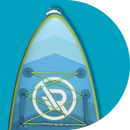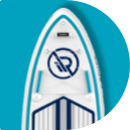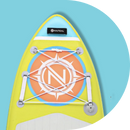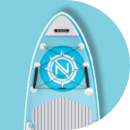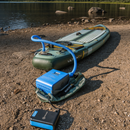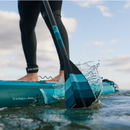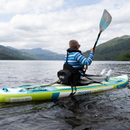Paddle Board Surfing: A Beginner's Guide
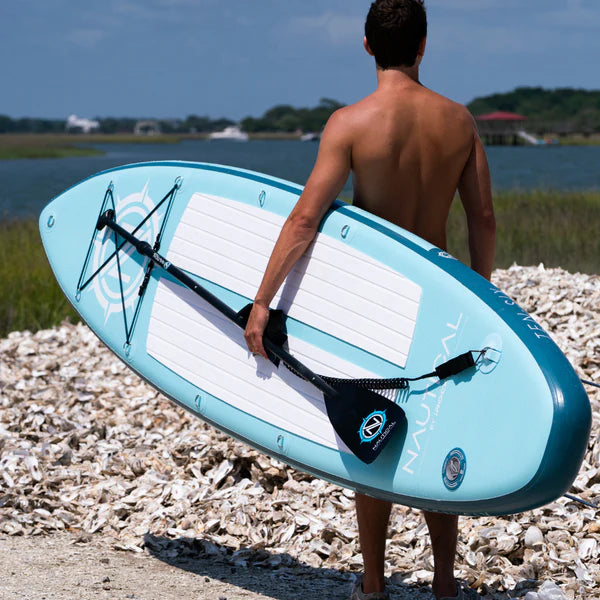
Paddle board surfing is a popular water activity blending surfing and paddling. Surfers of all skill levels who love challenging the waves can experience this unique and thrilling sport.
Check out our article where we'll delve into whether you can use a paddle board for surfing and guide you through catching waves for the first time. Keep scrolling for all the details!
Can You Use a Paddle Board to Surf?
Yes, it's possible to use a paddle board to surf. People call it SUP surfing.
However, there are a few things to learn before paddle board surfing, including choosing the proper stand up paddle board (considering its stability, durability, and maneuverability) and mastering the technique (including balancing, catching, and riding waves).
A hard (rigid) SUP board and an inflatable SUP board are two common choices that all surfers find hard to decide. There are things to consider, including stability, durability, portability, performance, and cost. Overall, it all depends on your preferences and priorities. A hard board can be a better choice if you value performance and stability when surfing over portability. However, go for the inflatable one if portability, affordability, and ease of use are your priorities.
How to Use Stand-up Paddle Boarding for Surfing?
Follow the below guidelines on how to surf on a stand up paddle board to start surfing on the paddle board:
1. Choosing the Right Surfing Paddle Board
An appropriate surfing paddle board may have a big impact on your performance. Here are some suggestions to help you select the most suitable item:
- Size: 8 to 10 feet is the ideal length for a SUP surfing board, which should be customized to the user's size for stability and agility.
- Shape: Surfing with a paddle board that resembles a rocket shape will help you with wave catching and mobility.
- Volume and Thickness: Go for the one with board volume and thickness as it will provide the essential balance between stability and responsiveness while paddle board surfing.
- Fin Setup: A multi-fin configuration improves wave tracking and control.
Besides the board, you should consider the following gear:
- Leash: A coiled leash keeps the board accessible after falls.
- Paddle: Choose a paddle that is sturdy, lightweight, and has a length adjustment.
- Personal Flotation Device: It can improve your safety, especially for newbies.
- Protection: Rash guards or wetsuits will be useful in providing comfort and protecting you from the elements.
2. Mastering the Paddle Technique
If you don’t know how to stand up paddle board surf, follow this instruction: Maintain a straight upper arm.
It is important, as bending will cause you to paddle too harshly and inefficiently. Shorter, higher-frequency strokes are useful if you want to catch waves, while longer and stronger strokes should be used while gliding.
3. Balancing on the Paddle Board
When paddling in a straight direction, stand 90 degrees to the board to keep balance. Once you catch a wave or a glide, you should switch to a surfing stance and put one foot forward.
Paddle with your feet "offset" to increase stability since the "surf" or offset posture is less stable. Maintaining balance becomes more difficult if you have a narrower board. For most people, boards measuring between 28 and 30 inches provide adequate stability.
4. Use Core Strength
When you engage in SUP surfing, you are in for a full-body workout that challenges both your dynamic and static balance.
While standing and making turns, your core, back, and leg muscles work together in perfect harmony, allowing you to ride the waves with ease. The key to conquering this sport is to practice maintaining balance as you navigate the ever-changing waters. With dedication and hard work, you can become a skilled SUP surfer.
Best Paddle Board for SUP Surfing
Can you surf with a paddle board? Yes, definitely, you can do it. And if you have a paddle board to start with, here is our suggestion:
1. BLACKFIN Model V
The BLACKFIN Model V is a top-tier inflatable paddle board designed for SUP surfing. It features a pointed nose, narrow tail, and rocker profile for agility. Made from triple-layer PVC, it has a carbon rail for rigidity. The tri-fin setup enhances stability, and the textured deck pad ensures grip. The board is 12'6" long and 32" wide, weighs 30 lbs, and can carry up to 485 lbs.
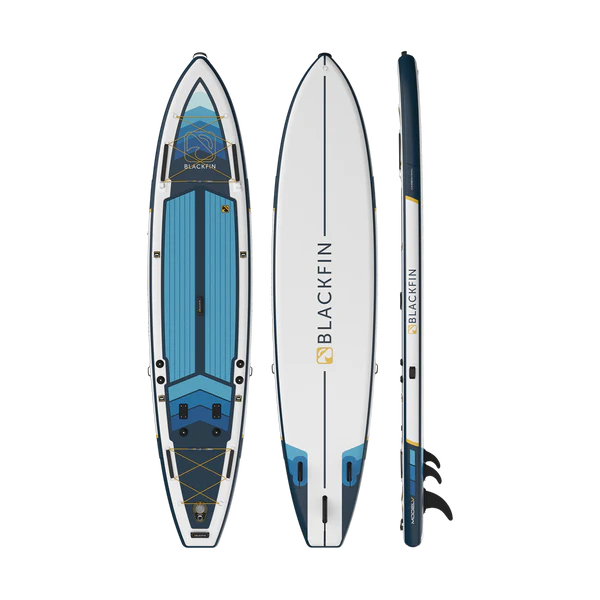
2. iROCKER Cruiser 10'6"
The iROCKER Cruiser 10'6" is an inflatable paddle board perfect for paddle board surfing and other water activities. It features a stable, smooth design with a wide nose, square tail, and gentle rocker. Made of triple-layer PVC, it has a tri-fin setup for versatility. The board also features a soft EVA deck pad for comfort. It weighs 25 pounds and can hold up to 400 pounds, making it suitable for people of different sizes and weights.

How To Catch a Wave When Paddle Boarding Surfing
Can a paddle board be used for surfing? Now you know the answer is yes. However, how do you catch a wave with it? Let's find out!
1. Lay Down On Your SUP
To begin paddle board surfing, step onto the paddle board, drop into the chest-deep water and begin paddling with your arms.
2. Balancing on the Paddle Board
To navigate a wave break, position your paddle close to your chest and handle towards the board's nose. Once past the break, wait in the lineup for waves and watch for them. Once you've successfully navigated past the waves, continue to keep an eye out for them farther down the lineup.
3. Standing Up
When you spot a surfable wave, raise yourself up onto your arms and stand while keeping the paddle on the board. Remember to keep your knees bent for balance and have a smooth ride onto the wave.
4. Paddling
It's important to maintain paddling since it will make it simpler to catch the wave. Riding the wave without paddling might be challenging, so SUP surfing with your preferred method, but remember to keep rowing. It will get you to the wave at a comparable pace, which will make riding the wave easier.
5. Catching and Riding Waves
When the wave starts pushing you, ride confidently and change your stance to surfing. Maintain stability by staying in the middle of the board and bending your knees. Be prepared for moments when the board feels overpowered, and you can't control it well. However, you'll gain a deeper understanding of waves over time. The key is to switch to the surfer stance after the wave takes.
SUP Surfing Etiquette for Beginners
When paddle board surfing with people on the same waves, there are several guidelines to follow so that everyone may enjoy themselves safely:
- The surfer riding a wave has priority over the one returning to the peak through breakers, who have to judge the surfer's direction and adjust accordingly.
- Priority is given to the first surfer who catches a wave. You should skip it and wait for the next one.
- When two surfers are riding the same wave, the priority belongs to the one closer to the breaking point, and the other one needs to leave the wave.
- Shouting "YEP YEP YEP" is a signal to let others know you're on a wave. Choose a peak with fewer surfers to prevent "taxing," even if the waves aren't as good. You can get along with other surfers after you get experience, but you should always be cautious.
Conclusion
Many surfers like paddle board surfing since the art of the sport requires a combination of strength, balancing, and timing skills. The riders need to stand atop a paddle board and catch waves by moving through the water with a paddle.
If you're a newbie and want to conquer the waves, don't forget to follow our guidelines above. Visit iROCKER if you need a high-quality paddle board to start the challenge.
